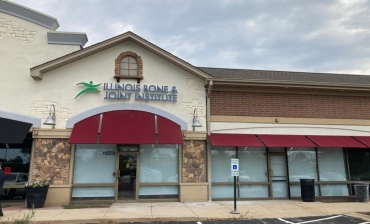Marjorie was 49 when she decided to look into bilateral knee replacement surgery (also called knee arthroplasty). Tired of waking up each day with knee pain, she scheduled appointments with doctors to inquire about the surgery but was frustrated with their responses.
Doctors told Marjorie she was too young for knee replacement surgery and advised her to try to lose weight. “If your knees hurt, you really can’t exercise, and you can’t walk,” Marjorie explains.
Thankfully, she learned about IBJI and its founder Wayne Goldstein, MD. “My boss at the time had hip replacement surgery, and Dr. Goldstein was the surgeon. He recommended him to me.”
Read on to hear the rest of Marjorie’s story, and learn how she’s doing all these years since her bilateral knee replacement surgery.
Bilateral Knee Replacement Surgery to Treat Bone-on-Bone Pain
It was a 35-mile drive from her Darion home to Glenview, but Marjorie didn’t mind. “By the time I saw Dr. Goldstein, it was bone-on-bone in both knees,” she says. “There was no cartilage left. I was willing to go up there to see him to have the surgery.”
Dr. Goldstein greeted Marjorie with a matter-of-fact approach. He recommended that she have total knee replacement surgery on both knees simultaneously. He told her she was not too young to have a bilateral knee replacement and confirmed what she knew to be true: you can’t lose weight if you can’t walk.
The hardest part for Marjorie was waiting for the surgery since Dr. Goldstein was booked. “I think I saw him in May, and I scheduled the surgery for August,” she said.
Knee Replacement Surgery Candidate
Marjorie had spent a lifetime dealing with knee pain. It started when she fell off her bike as a teenager and dislocated her left knee. “I already had a big scar down the front of my leg from that,” she recalls. “I spent a whole summer with my leg in a cast.”
Throughout her high school years, she could not participate in gym class, join sports, or be part of recreational activities.
“Other people were roller skating, but I couldn’t do any of that,” Marjorie says. “I favored my knees. I was a lot more careful than many other people my age and learned to live with my limitations.”
Deciding to Have Bilateral Knee Replacement Surgery
Two decades ago, Marjorie worked from home, long before it was common. “I had a great boss who understood that I couldn’t walk and my legs hurt, so I worked from home a couple of days a week,” she says.
“What set me off to have the surgery was that the building that I worked in had a really bad parking lot. I stepped in a crack in the parking lot, turned my leg, and tore something. My leg was swollen and messed up for days.”
Knee Replacement Surgery Recovery
Following her successful bilateral knee replacement surgery, Marjorie went to live in a rehabilitation facility where she had a private room. She says she valued the time she was able to recover and work with therapists to build up her strength and mobility.
Marjorie was confident that she’d get better with hard work, the help of her therapists, and support from her husband, who drove many miles to see her daily during her stay.
“The people were great,” she says. “They did a great job of getting me ready to come home. I was able to walk up and down the stairs and take a shower. They even had my husband come one day with the car, so I could practice getting in and out of it.”
After returning home, Marjorie continued her knee replacement recovery with outpatient rehab for six weeks.
Doctor Visits Following Knee Surgery
Initially, follow-up visits happened monthly for the first year and then annually for five years. At her most recent visit, which she scheduled with Dr. LaReau last June since it had been 20 years, she was pleasantly surprised to hear that her knees are still perfect.
Pain-Free Living After Knee Surgery
Marjorie says going the distance to see Dr. Goldstein for undergoing bilateral knee replacement surgery was “worth the miles.”
“The pain is gone,” she says. “I can’t think of anything I would have done differently.”
Activities that were excruciating before her knee replacement are now no problem for Marjorie. “I can get on a plane and sit for a long time and not worry about my knees hurting,” she says. “I’ve been to Hawaii, Florida, California, and I went to Europe two or three times.”
The double knee replacement surgery realigned Marjorie’s legs and removed her knock knees. She says she can exercise and go for long excursions without pain.
“Just to be able to walk is just amazing, and it did give me the incentive to lose weight,” she says
Advice About Considering Knee Replacement Surgery
Today, Marjorie is quite literally a walking spokesperson for knee replacement surgery. “I’ve counseled so many people about getting their knees done,” she says.
“I’ve recommended going through all of the services at IBJI because I can’t recommend them enough. One of my sisters had both of her knees replaced in another state, and my husband had his hip done at IBJI. If you’re on the fence, don’t be.”
Physical Therapy Following Knee Replacement Surgery
Marjorie’s best advice for anyone planning to schedule a bilateral knee replacement surgery is to follow through with physical therapy sessions.
“Don’t cheat on your therapy because you’re only cheating on yourself.” This is the same advice someone gave to her, and she says it kept her going while she was recovering at the inpatient rehab facility and after she arrived back home.
New Adventures After Knee Replacement Surgery
Besides traveling, Marjorie has enjoyed shopping with family members, walking her dog, painting the house, and more. “I really don’t think about my knees,” she says. “I don’t limit myself or ever hesitate to try something or do something. I do the things I want to do.”
See an IBJI Knee Surgeon
If you are experiencing knee pain, schedule a consultation to diagnose your knee problems. Let us be your guide back to a fully functioning knee. Learn more about bilateral knee replacement surgery at IBJI.
Illinois Bone & Joint Institute is one of Illinois’ largest orthopedic group practices. We have more than 150 physicians at 100 locations throughout the greater Chicago area. We’re experts in orthopedic treatments and have complete diagnostic and rehab services.
Last updated in May 2022.




